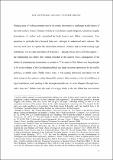Files in this item
Law and violence in eleventh-century France
Item metadata
| dc.contributor.author | McHaffie, Matthew William | |
| dc.date.accessioned | 2020-01-23T00:34:43Z | |
| dc.date.available | 2020-01-23T00:34:43Z | |
| dc.date.issued | 2018-02 | |
| dc.identifier | 259194202 | |
| dc.identifier | 52df0dc4-b97b-4499-8173-0589e2e5a696 | |
| dc.identifier | 85041539443 | |
| dc.identifier.citation | McHaffie , M W 2018 , ' Law and violence in eleventh-century France ' , Past & Present , vol. 238 , no. 1 , pp. 3–41 . https://doi.org/10.1093/pastj/gtx056 | en |
| dc.identifier.issn | 0031-2746 | |
| dc.identifier.other | ORCID: /0000-0002-9701-0357/work/58531609 | |
| dc.identifier.uri | https://hdl.handle.net/10023/19339 | |
| dc.description | The research for this paper was made possible by a Leverhulme Trust Early Career Fellowship | en |
| dc.description.abstract | This article re-examines the significance of descriptions of violence (violentia) in eleventh-century ecclesiastical charters from northwestern France. Previous historiography has tended to assume, or argue explicitly, that the language of violentia was connected to the absence or weakness of contemporary legal institutions. This article suggests, instead, that such language acquired shape and meaning within the framework of those very courts. It demonstrates that violentia reflects processes of bringing legal claims to court-holders, and that the meaning of violentia was inextricably connected to how the jurisdiction of those court-holders was understood. It then argues that violentia was used as a form of legal argument in express juxtaposition to land claims whereby litigants attempted to fix a court’s attention on violentia to the exclusion of wider normative issues centred on right in land. The article then considers why this might have been the case, and suggests that profound changes in how eleventh-century individuals conceptualised property rights created serious problems in courts which violentia as a form of argument sought to avoid. This article therefore offers not only a new way of reading eleventh-century ecclesiastical charters, but offers a new paradigm for thinking about why violence develops as a legal concept in the central middle ages. | |
| dc.format.extent | 39 | |
| dc.format.extent | 459858 | |
| dc.language.iso | eng | |
| dc.relation.ispartof | Past & Present | en |
| dc.subject | DC France | en |
| dc.subject | T-NDAS | en |
| dc.subject | SDG 16 - Peace, Justice and Strong Institutions | en |
| dc.subject.lcc | DC | en |
| dc.title | Law and violence in eleventh-century France | en |
| dc.type | Journal article | en |
| dc.contributor.institution | University of St Andrews. School of History | en |
| dc.identifier.doi | https://doi.org/10.1093/pastj/gtx056 | |
| dc.description.status | Peer reviewed | en |
| dc.date.embargoedUntil | 2020-01-23 |
This item appears in the following Collection(s)
Items in the St Andrews Research Repository are protected by copyright, with all rights reserved, unless otherwise indicated.

